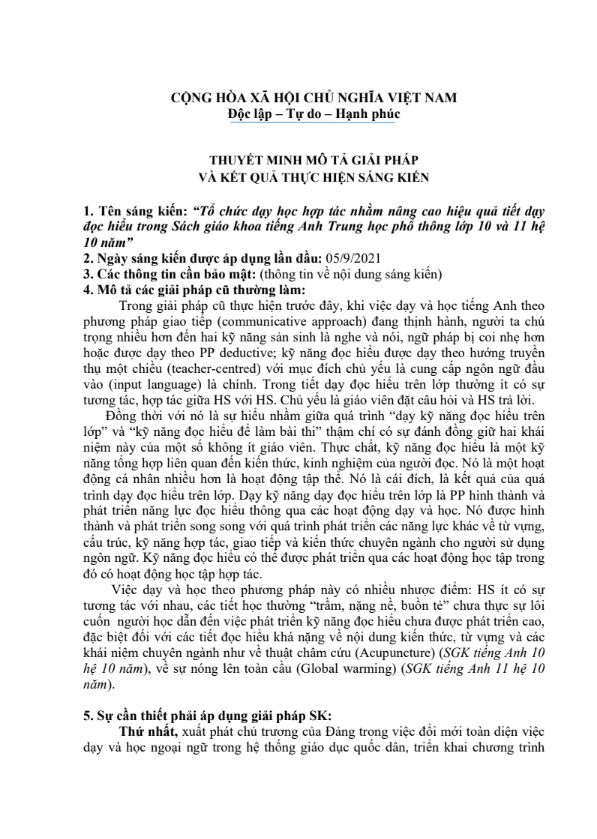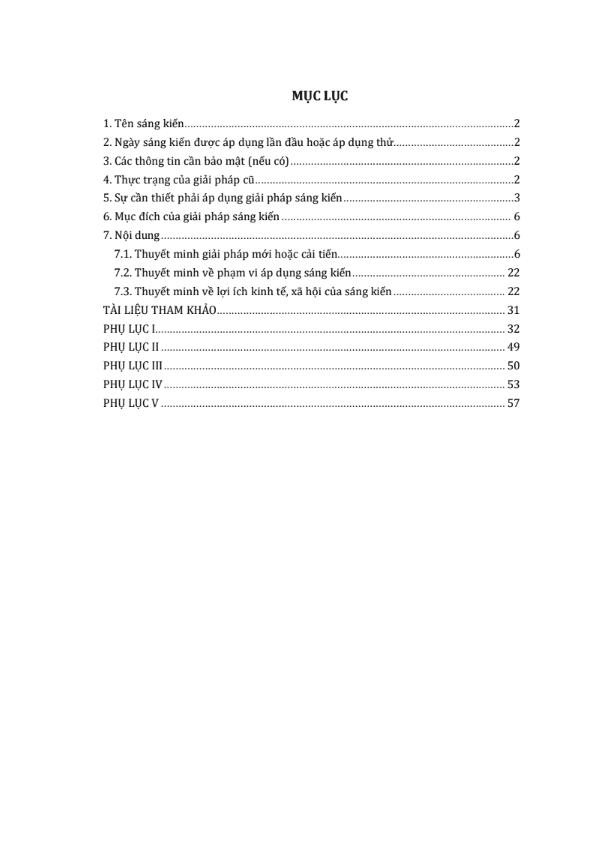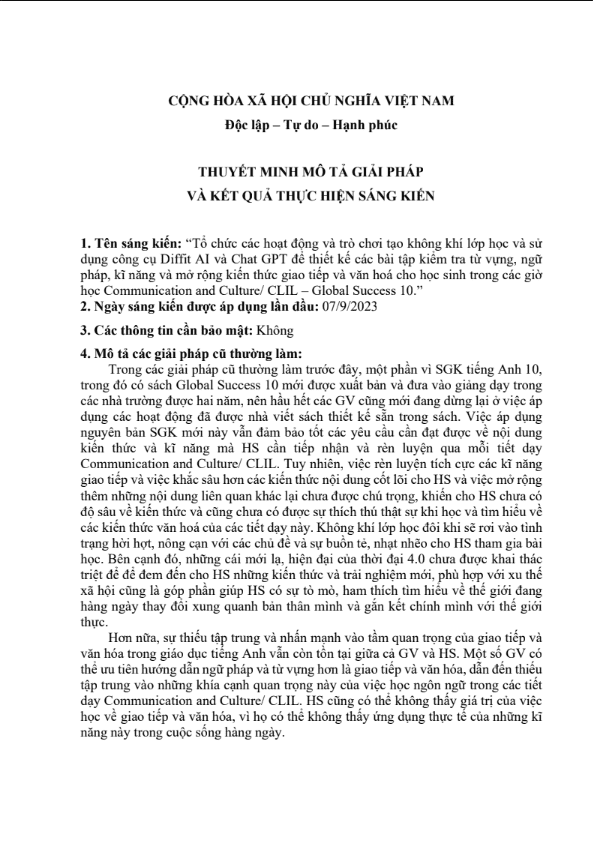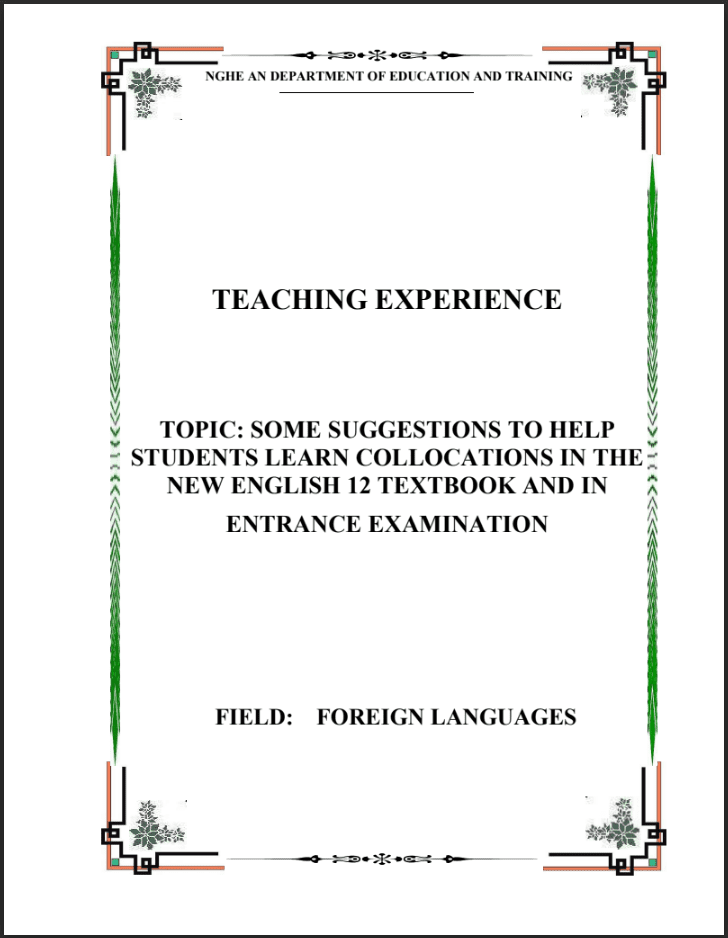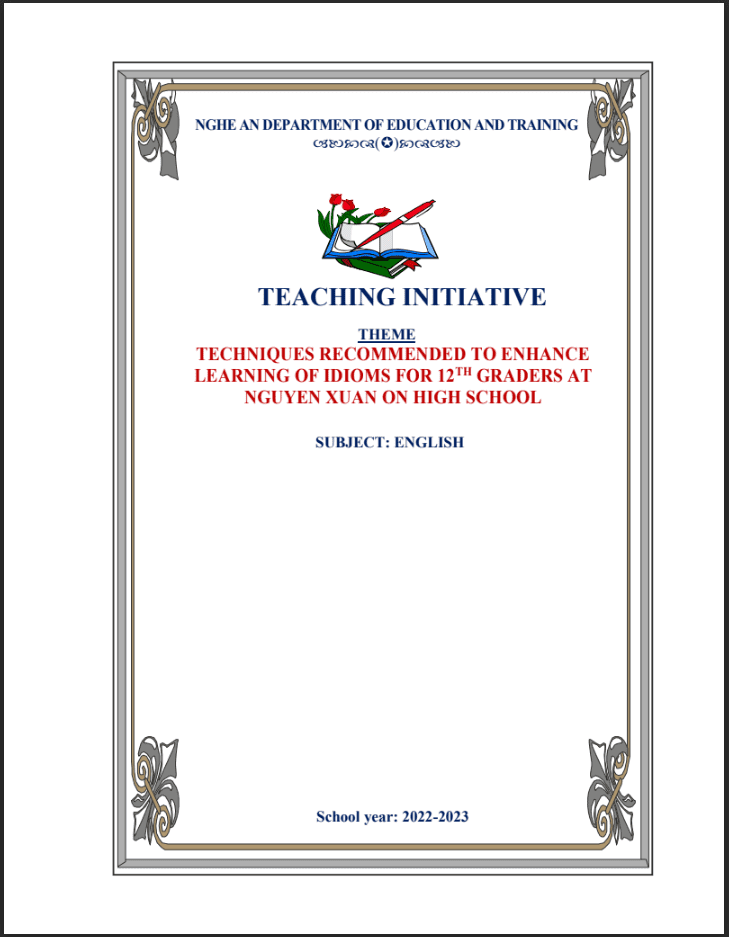SKKN The application of task based approach in teaching speaking lessons in English 10 (new textbook)
- Mã tài liệu: MP0094 Copy
| Môn: | Tiếng Anh |
| Lớp: | 10 |
| Bộ sách: | Global Success |
| Lượt xem: | 470 |
| Lượt tải: | 1 |
| Số trang: | |
| Tác giả: | Trần Thị Hương Lan |
| Trình độ chuyên môn: | Thạc sĩ giáo dục |
| Đơn vị công tác: | THPT Nghi Lộc 5 |
| Năm viết: | 2022-2023 |
| Số trang: | |
| Tác giả: | Trần Thị Hương Lan |
| Trình độ chuyên môn: | Thạc sĩ giáo dục |
| Đơn vị công tác: | THPT Nghi Lộc 5 |
| Năm viết: | 2022-2023 |
Sáng kiến kinh nghiệm “The application of task based approach in teaching speaking lessons in English 10 (new textbook)”triển khai gồm các biện pháp nổi bật sau:
Mô tả sản phẩm
PART A: INTRODUCTION
1. Reasons for choosing the study
In today‟s global world, the importance of English can‟t be denied. English is the greatest common language spoken universally. English is used for socialising, entertainment as well as work. In learning English, we should master both language skills and language components. Language skill consists of two divisions that are receptive skill and productive skill. Receptive skill consists of listening and reading skill while productive skill consists of speaking and writing skill.
With the demand and the necessity of communicating English, four language skills including listening, speaking, reading, writing have been given balanced weight in the national syllabus of English teaching for high school students.
Among these skills, both teachers and learners find it hard to use an effective way in teaching and learning speaking skill. Every lesson contains five parts: reading, speaking, listening, writing and language focus – the aim is to develop the students‟ language skills totally. In reality, most teachers, specially in rural area mainly concentrate on grammar and students do not care much about other skills because their examinations require the skills of grammar- no motivation for them to speak. In some schools, the teachers are teaching speaking skills, however they usually follow traditional ways or Present- Practice- Produce approach. As a result, most students graduated from high schools could not communicate in English effectively.
Touching this pedagogical context, this study emphasizes on investigation into the application of task- based approach in speaking skills to the 10th students at Nghi Loc 5 high school in Nghe An province. By applying task based learning, the educators can create a course around communicative tasks to encourage students to their real- world activities. For all above mentioned reasons, we carries out the study entitled “The application of task based approach in teaching speaking lessons in English 10”. Hopefully, the results could serve as a useful source of references for teachers and students.
2. Objectives of the study
With the above reasons, we have decided to carry out the thesis with the purpose of:
- Helping students realize the importance of speaking skill.
- Evaluating the effectiveness of the task based approach in teaching English speaking skill at Nghi Loc 5 High school.
- Suggesting some solutions and implications to promote English speaking teaching based on the task-based approach at Nghi Loc 5 High school.
- Helping foreign language teachers have more suggestions in teaching speaking
3. Significance of the study
Teaching English speaking skills is a challenge for teachers in non-native English speaking countries. In reality, language learners often neglect to join English-speaking activities. Moreover, they tend to focus on grammar, not meaning. To deal with this problem, English teachers can take advantage of the task-based approach (TBA) for their speaking classes. In fact, TBA is considered a useful approach to help learners improve speaking skills effectively. It is also called the learner-centered approach, which emphasizes the roles of learners‟ roles during the learning process.
- Scope of the study:
The topic studies the application of task based approach in teaching speaking lessons in English 10 at Nghi Loc 5 High School
5. Methods of the study
- Study of theories
- Observation of real situation
- Analysis and evaluation
6. New features in the study’s result
In our innovation, this approach is suitable for all levels of students, influence the class environment and help students enjoy studying speaking. Moreover, the teachers can use and adapt the approach flexibly in their teaching process.
PART B: CONTENT
CHAPTER 1: LITERATURE REVIEW
1. Speaking skill
1.1. Communicative competence
It is obvious that speaking is the key to human communication. It is usually considered the most important goal in language learning. Up to now, there have been many definitions of speaking. Chaney states that speaking is “the process of building and sharing meaning through the use of verbal and non-verbal symbols, in a variety of contexts” (Chaney, 1998: p13).
With the same point of view, Byrne (1976:8) confirms: “speaking is a two-way process between the speaker(s) and the listener(s) involving the productive skill of speaking and the receptive skill of understanding.” Both the listener and the speaker engage in the speech. The speaker transmits the information and the listener has to receive or understand that information. That we call it is the process of encode massage (speaker) and decode message (listener). The message contains a great deal of information that the listener needs. And at the same time, the listener is helped by the speakers‟ prosodic features such as stress and intonation which accompany the spoken utterances and form part of its meaning, and also by his facial and body movements.
Brown (1983) also states that “speaking is an interactive process of constructing meaning that involves producing, receiving and processing information.” One more, he confirms the interaction between speaker and listener in speaking. However, its form and meaning are dependent on the context in which it occurs, including the participants themselves, their collective experiences, the physical environment, and the purposes for speaking.
In short, speaking can be seen as the way people interact and share information. It is the ability in using oral language to explore ideas, intentions, thoughts and feelings to other people as a way to make the message clearly delivered and well understood by the hearer. It can be confirmed that the major purpose of teaching speaking is to train the learner oral fluency, the ability to express oneself intelligibly, accurately.
1.2. Teaching and learning speaking
It is obvious that speaking is the key to human communication. It is usually considered the most important goal in language learning. Up to now, there have been many definitions of speaking. Chaney states that speaking is “the process of building and sharing meaning through the use of verbal and non-verbal symbols, in a variety of contexts” (Chaney, 1998: p13).
With the same point of view, Byrne (1976:8) confirms: “speaking is a two-way process between the speaker(s) and the listener(s) involving the productive skill of speaking and the receptive skill of understanding.” Both the listener and the speaker engage in the speech. The speaker transmits the information and the listener has to receive or understand that information. That we call it is the process of encode massage (speaker) and decode message (listener). The message contains a great deal of information that the listener needs. And at the same time, the listener is helped by the speakers‟ prosodic features such as stress and intonation which accompany the spoken utterances and form part of its meaning, and also by his facial and body movements.
Brown (1983) also states that “speaking is an interactive process of constructing meaning that involves producing, receiving and processing information.” One more, he confirms the interaction between speaker and listener in speaking. However, its form and meaning are dependent on the context in which it occurs, including the participants themselves, their collective experiences, the physical environment, and the purposes for speaking.
In short, speaking can be seen as the way people interact and share information. It is the ability in using oral language to explore ideas, intentions, thoughts and feelings to other people as a way to make the message clearly delivered and well understood by the hearer. It can be confirmed that the major purpose of teaching speaking is to train the learner oral fluency, the ability to express oneself intelligibly, accurately.
1.3. Types of speaking activities
According to Brown (2001),there are two types of oral language: monologue and dialogue.
- Monologue
In Brown and Yule‟s opinion (1983), a monologue involves one speaker using spoken language for any length of time. It is the ability to give an uninterrupted oral presentation, such as speaking in public, reading news in radio or television programs, giving a formal lecture, announcing the instruction or changes in the airport, etc. In this type of oral language there is no reaction or response from listener. It is usually used when the speaker would like to talk with a large number of listeners about the same issue. The speech of speaker may be planned or unplanned. The planned speech usually manifests little redundancy and it is therefore more difficult for the listeners to comprehend than the unplanned speech.
- Dialogue
A dialogue, conversely, involves two or more speakers to promote the social relationship (transactional) and propositional or factual information (interactional). There are turn takings to change the roles of speakers and listeners in this type. In this case the participants may have a good deal of sharing knowledge. If the participants are familiar the conversation could contain more assumptions even other meaning hidden lines. In constrast, with the unfamiliar interlocutors the speech must be more explicit to assure the effective comprehension. Byrne (1986) also said: “Dialogues seem to be best suited to the teaching of the spoken language”.
1.4. Difficulties in teaching speaking
1.4.1 Problems with Speaking
Speaking skill is considered to be similar to oral communication skill. Brown (2000) states that some characteristics of spoken language can make oral performance easy as well as, in some cases, difficult.
Clustering
To make speech fluently, the speaker usually use phrases, not word by word that can prevent learners from making fluent conversation.
Redundancy
Depending on unplanned or planned speech, the speaker could make redundancy of language and have opportunities to explicit the information. However, this also causes confusing to the learners when they use target language.
Reduced Forms
Teaching spoken language sometimes faces with problems of contractions, elisions, reduced vowels, etc.,. This makes students make a stilted, bookish quality of speaking.
TÀI LIỆU LIÊN QUAN
- 7
- 105
- 1
- [product_views]
- 5
- 173
- 2
- [product_views]
- 4
- 165
- 3
- [product_views]
- 4
- 129
- 4
- [product_views]
100.000 ₫
- 6
- 434
- 5
- [product_views]
100.000 ₫
- 2
- 507
- 6
- [product_views]
100.000 ₫
- 9
- 546
- 7
- [product_views]
100.000 ₫
- 4
- 409
- 8
- [product_views]
100.000 ₫
- 2
- 595
- 9
- [product_views]
100.000 ₫
- 0
- 538
- 10
- [product_views]


